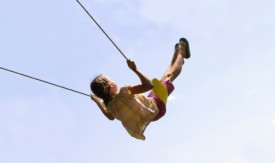
The human mind is most engaged to react and perform at optimal capacity when our hearts are pumping and our blood is flowing. Any athlete will tell you that he or she feels most alive and sharp when they are in the midst of the contest, heart beating hard, mind alert and ready. Given the interconnected nature of how our brains and bodies function, how the brain gets more oxygen and works better when the heart is pumping, it’s easy to see that we are designed not only to learn, but to think best “on our feet.”
In fact, this concept extends far beyond circulation alone; physical activity has been shown to have substantive affects on brain chemistry. In 2003, Sibley and Etnier demonstrated that, for 4-18 year-olds, exercise positively impacts perception skills, IQ, achievement, verbal and math scores, development and academic readiness. [i] Exercise can affect the release of neurotransmitters key to the learning process, such as norepinephrine (which increases blood flow to skeletal muscles as well as to the brain) and acetylcholine (which can slow the heart rate and contribute to sustained attention).
With these concepts in mind, now imagine the modern classroom. The average student sits for hours a day usually sitting still. She shouldn’t stand up and stretch, or worse, walk around the classroom. (For goodness sake, that’s distracting to the other students and disrespectful to the teacher.) Physical education programs are getting cut due to shrinking budgets, and recess time is being cut to create more opportunities for test preparation. Obesity and diabetes are dangerously on the rise. Since the early 1970s, the number of overweight students has quadrupled from four percent to seventeen percent. ( American Heart Association)
In general, the classroom becomes a place where we expect students to focus the mind and quiet the body. What we’re learning is that this is just not necessarily the best way to go. A new trend in classroom management is bringing this tradition into question. Through what is becoming known as “physically active learning,” educators are not only experimenting with integrating more physical activity into classroom lessons, but they are generating positive results.
According to Jena Mee, a physical education and school health education consultant for the Department of Education, “Research is showing us very persuasively that if students exercise for sustained periods of time before they do challenging work, they perform cognitive tasks better, they remember things better, they can apply their skills better.” [ii]
In theory, the idea is to break up lessons with short breaks of physical activity that get students up out of their seats and moving around the room. According to eSchool News, “The approach also has been shown to improve attendance and student behavior and reduce discipline referrals.”
As educators under pressure to maximize student academic performance, we often focus on the material and forget that our real goal is to help the whole child. This research is just one more reminder that we need to attend to the body as well as the mind. If we can do both, we will help our students become all that much more successful.
While the research is still developing, you can get the story as reported this past May on eschoolnews.com.
And if you want to explore one idea to bring more physical activity into your classroom, how about using exercise balls instead of chairs?
[i]Sibley B.A. and Etnier J.L. (2003). The relationship between physical activity and cognition in children: a meta- analysis. Pediatric Exercise Science, 15:243-256.
[ii] ‘Physically active learning’ improves test scores, sharpens concentration. eSchool News. May 16, 2011.

